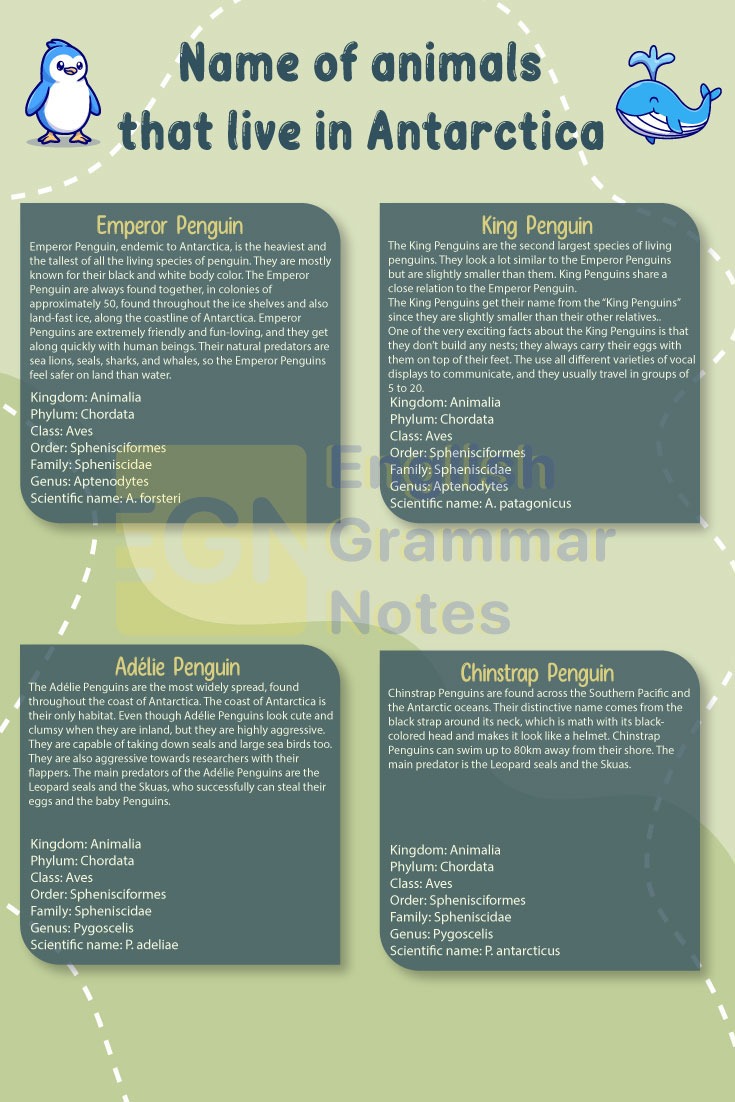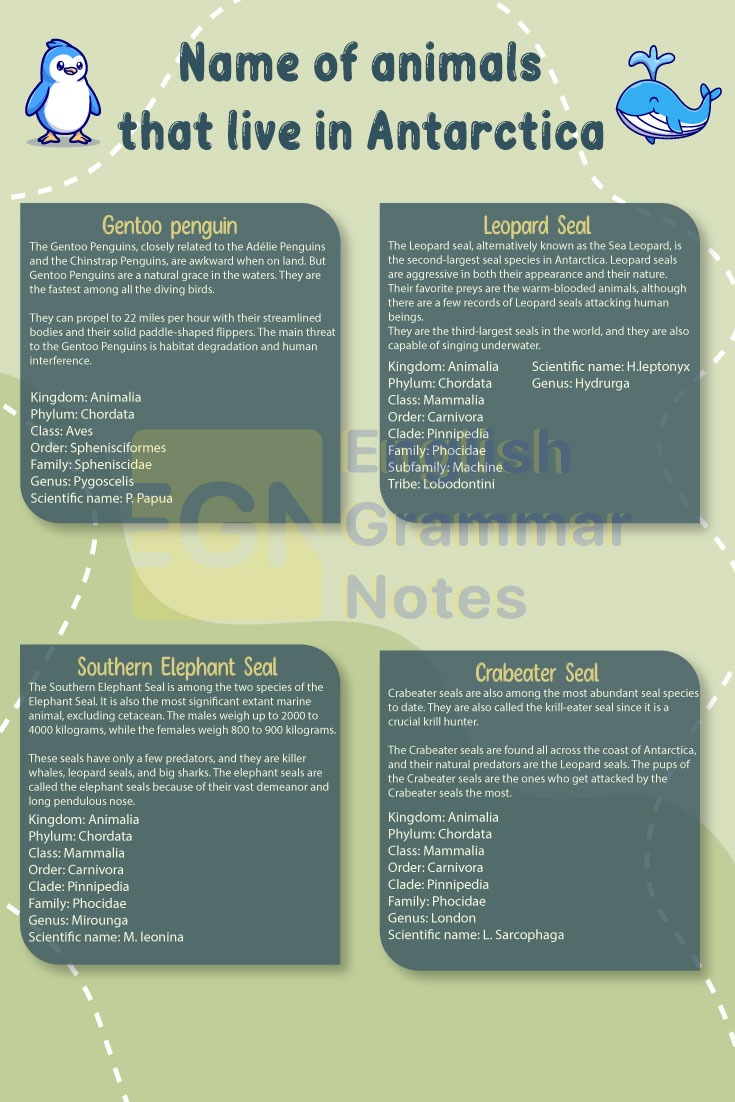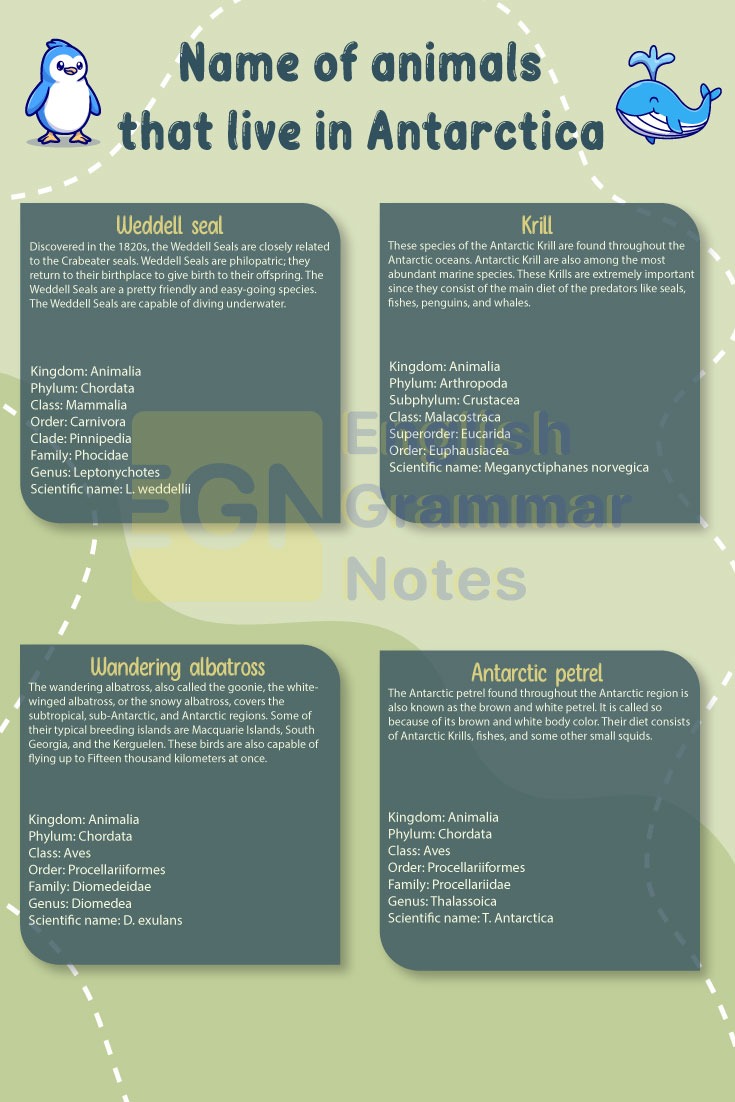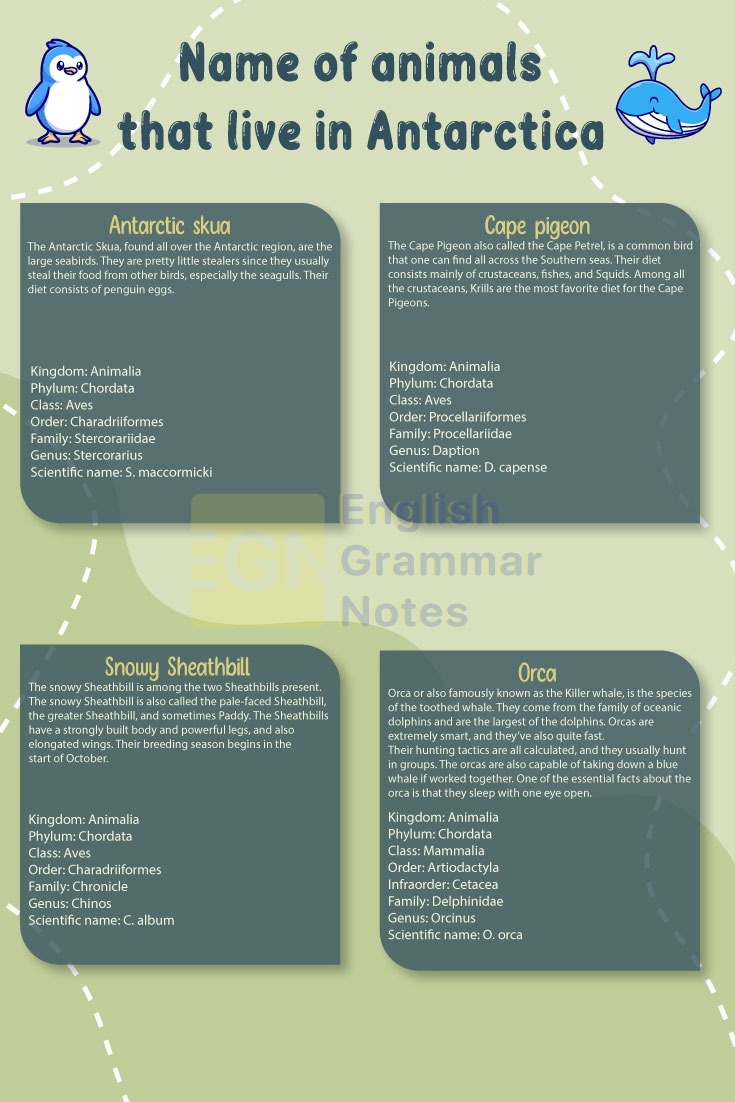Antarctica Animals: Antarctica has always been on people’s minds when it comes to knowing and exploring that part of the world. It has one of the most extreme climatic conditions, making it difficult for everyday survival.
This results in our curiosity about the animals and plants in Antarctica. Do you really know how many animals live in Antarctica? So today, let’s discuss the list of animals living in Antarctica.
Study the most important English Vocabulary Words identified by our experts and learn the right vocabulary to use in your day to day conversations
List of Animals in Antarctica
Name of animals that live in Antarctica
- Emperor Penguin
- King Penguin
- Adélie Penguin
- Chinstrap Penguin
- Gentoo penguin
- Leopard Seal
- Southern Elephant Seal
- Crabeater Seal
- Weddell seal
- Krill
- Wandering albatross
- Antarctic petrel
- Antarctic skua
- Cape pigeon
- Snowy Sheathbill
- Orca
- Snailfish
- Cod icefish
- Antarctic toothfish
- Antarctic silverfish
- Blue Whale
- Colossal Squid
Fascinating facts about the animals on the list
Emperor Penguin
Emperor Penguin, endemic to Antarctica, is the heaviest and the tallest of all the living species of penguin. They are mostly known for their black and white body color. The Emperor Penguin are always found together, in colonies of approximately 50, found throughout the ice shelves and also land-fast ice, along the coastline of Antarctica. Emperor Penguins are extremely friendly and fun-loving, and they get along quickly with human beings. Their natural predators are sea lions, seals, sharks, and whales, so the Emperor Penguins feel safer on land than water.
| Kingdom | Animalia |
| Phylum | Chordata |
| Class | Aves |
| Order | Sphenisciformes |
| Family | Spheniscidae |
| Genus | Aptenodytes |
| Scientific name | A. forsteri |
King Penguin
The King Penguins are the second largest species of living penguins. They look a lot similar to the Emperor Penguins but are slightly smaller than them. King Penguins share a close relation to the Emperor Penguin.
The King Penguins get their name from the “King Penguins” since they are slightly smaller than their other relatives.
One of the very exciting facts about the King Penguins is that they don’t build any nests; they always carry their eggs with them on top of their feet. The use all different varieties of vocal displays to communicate, and they usually travel in groups of 5 to 20.
| Kingdom | Animalia |
| Phylum | Chordata |
| Class | Aves |
| Order | Sphenisciformes |
| Family | Spheniscidae |
| Genus | Aptenodytes |
| Scientific name | A. patagonicus |
Adélie Penguin
The Adélie Penguins are the most widely spread, found throughout the coast of Antarctica. The coast of Antarctica is their only habitat. Even though Adélie Penguins look cute and clumsy when they are inland, but they are highly aggressive. They are capable of taking down seals and large sea birds too.
They are also aggressive towards researchers with their flappers. The main predators of the Adélie Penguins are the Leopard seals and the Skuas, who successfully can steal their eggs and the baby Penguins.
| Kingdom | Animalia |
| Phylum | Chordata |
| Class | Aves |
| Order | Sphenisciformes |
| Family | Spheniscidae |
| Genus | Pygoscelis |
| Scientific name | P. adeliae |
Chinstrap Penguin
Chinstrap Penguins are found across the Southern Pacific and the Antarctic oceans. Their distinctive name comes from the black strap around its neck, which is math with its black-colored head and makes it look like a helmet. Chinstrap Penguins can swim up to 80km away from their shore. The main predator is the Leopard seals and the Skuas.
| Kingdom | Animalia |
| Phylum | Chordata |
| Class | Aves |
| Order | Sphenisciformes |
| Family | Spheniscidae |
| Genus | Pygoscelis |
| Scientific name | P. antarcticus |

Gentoo penguin
The Gentoo Penguins, closely related to the Adélie Penguins and the Chinstrap Penguins, are awkward when on land. But Gentoo Penguins are a natural grace in the waters. They are the fastest among all the diving birds.
They can propel to 22 miles per hour with their streamlined bodies and their solid paddle-shaped flippers. The main threat to the Gentoo Penguins is habitat degradation and human interference.
| Kingdom | Animalia |
| Phylum | Chordata |
| Class | Aves |
| Order | Sphenisciformes |
| Family | Spheniscidae |
| Genus | Pygoscelis |
| Scientific name | P. Papua |
Leopard Seal
The Leopard seal, alternatively known as the Sea Leopard, is the second-largest seal species in Antarctica. Leopard seals are aggressive in both their appearance and their nature. Their favorite preys are the warm-blooded animals, although there are a few records of Leopard seals attacking human beings.
They are the third-largest seals in the world, and they are also capable of singing underwater.
| Kingdom | Animalia |
| Phylum | Chordata |
| Class | Mammalia |
| Order | Carnivora |
| Clade | Pinnipedia |
| Family | Phocidae |
| Subfamily | Machine |
| Tribe | Lobodontini |
| Genus | Hydrurga |
| Scientific name | H.leptonyx |
Southern Elephant Seal
The Southern Elephant Seal is among the two species of the Elephant Seal. It is also the most significant extant marine animal, excluding cetacean. The males weigh up to 2000 to 4000 kilograms, while the females weigh 800 to 900 kilograms.
These seals have only a few predators, and they are killer whales, leopard seals, and big sharks. The elephant seals are called the elephant seals because of their vast demeanor and long pendulous nose.
| Kingdom | Animalia |
| Phylum | Chordata |
| Class | Mammalia |
| Order | Carnivora |
| Clade | Pinnipedia |
| Family | Phocidae |
| Genus | Mirounga |
| Scientific name | M. leonina |
Crabeater Seal
Crabeater seals are also among the most abundant seal species to date. They are also called the krill-eater seal since it is a crucial krill hunter.
The Crabeater seals are found all across the coast of Antarctica, and their natural predators are the Leopard seals. The pups of the Crabeater seals are the ones who get attacked by the Crabeater seals the most.
| Kingdom | Animalia |
| Phylum | Chordata |
| Class | Mammalia |
| Order | Carnivora |
| Clade | Pinnipedia |
| Family | Phocidae |
| Genus | London |
| Scientific name | L. Sarcophaga |

Weddell seal
Discovered in the 1820s, the Weddell Seals are closely related to the Crabeater seals. Weddell Seals are philopatric; they return to their birthplace to give birth to their offspring. The Weddell Seals are a pretty friendly and easy-going species. The Weddell Seals are capable of diving underwater.
| Kingdom | Animalia |
| Phylum | Chordata |
| Class | Mammalia |
| Order | Carnivora |
| Clade | Pinnipedia |
| Family | Phocidae |
| Genus | Leptonychotes |
| Scientific name | L. weddellii |
Krill
These species of the Antarctic Krill are found throughout the Antarctic oceans. Antarctic Krill are also among the most abundant marine species. These Krills are extremely important since they consist of the main diet of the predators like seals, fishes, penguins, and whales.
| Kingdom | Animalia |
| Phylum | Arthropoda |
| Subphylum | Crustacea |
| Class | Malacostraca |
| Superorder | Eucarida |
| Order | Euphausiacea |
| Scientific name | Meganyctiphanes norvegica |
Wandering albatross
The wandering albatross, also called the goonie, the white-winged albatross, or the snowy albatross, covers the subtropical, sub-Antarctic, and Antarctic regions. Some of their typical breeding islands are Macquarie Islands, South Georgia, and the Kerguelen. These birds are also capable of flying up to Fifteen thousand kilometers at once.
| Kingdom | Animalia |
| Phylum | Chordata |
| Class | Aves |
| Order | Procellariiformes |
| Family | Diomedeidae |
| Genus | Diomedea |
| Scientific name | D. exulans |
Antarctic petrel
The Antarctic petrel found throughout the Antarctic region is also known as the brown and white petrel. It is called so because of its brown and white body color. Their diet consists of Antarctic Krills, fishes, and some other small squids.
| Kingdom | Animalia |
| Phylum | Chordata |
| Class | Aves |
| Order | Procellariiformes |
| Family | Procellariidae |
| Genus | Thalassoica |
| Scientific name | T. Antarctica |

Antarctic skua
The Antarctic Skua, found all over the Antarctic region, are the large seabirds. They are pretty little stealers since they usually steal their food from other birds, especially the seagulls. Their diet consists of penguin eggs.
| Kingdom | Animalia |
| Phylum | Chordata |
| Class | Aves |
| Order | Charadriiformes |
| Family | Stercorariidae |
| Genus | Stercorarius |
| Scientific name | S. maccormicki |
Cape pigeon
The Cape Pigeon also called the Cape Petrel, is a common bird that one can find all across the Southern seas. Their diet consists mainly of crustaceans, fishes, and Squids. Among all the crustaceans, Krills are the most favorite diet for the Cape Pigeons.
| Kingdom | Animalia |
| Phylum | Chordata |
| Class | Aves |
| Order | Procellariiformes |
| Family | Procellariidae |
| Genus | Daption |
| Scientific name | D. capense |
Snowy Sheathbill
The snowy Sheathbill is among the two Sheathbills present. The snowy Sheathbill is also called the pale-faced Sheathbill, the greater Sheathbill, and sometimes Paddy. The Sheathbills have a strongly built body and powerful legs, and also elongated wings. Their breeding season begins in the start of October.
| Kingdom | Animalia |
| Phylum | Chordata |
| Class | Aves |
| Order | Charadriiformes |
| Family | Chronicle |
| Genus | Chinos |
| Scientific name | C. album |
Orca
Orca or also famously known as the Killer whale, is the species of the toothed whale. They come from the family of oceanic dolphins and are the largest of the dolphins. Orcas are extremely smart, and they’ve also quite fast.
Their hunting tactics are all calculated, and they usually hunt in groups. The orcas are also capable of taking down a blue whale if worked together. One of the essential facts about the orca is that they sleep with one eye open.
| Kingdom | Animalia |
| Phylum | Chordata |
| Class | Mammalia |
| Order | Artiodactyla |
| Infraorder | Cetacea |
| Family | Delphinidae |
| Genus | Orcinus |
| Scientific name | O. orca |

Snailfish
Snailfish are found all over the Arctic and the Antarctic oceans. Around 410 species of snailfish have been discovered, but it is believed that there are still many undescribed or undiscovered species out there. Snailfishes have adapted themselves to live in deeper depths than other fishes, and they usually stay in the trenches.
| Kingdom | Animalia |
| Phylum | Chordata |
| Class | Actinopterygii |
| Order | Scorpaeniformes |
| Superfamily | Cyclopteroidea |
Cod icefish
The Notothens, Nototheniidae, or cod icefishes, belongs from the family of the ray-finned fishes. They do not have swim bladders; hence they cannot swim up to the surface often, so they spend their lives in the depth of the oceans, mainly at the ocean bed.
But because they have a lighter skeleton, they swim up to the surface to catch their prey.
| Kingdom | Animalia |
| Phylum | Chordata |
| Class | Actinopterygii |
| Order | Perciformes |
| Suborder | Notothenioidei |
| Family | Nototheniidae |
Antarctic toothfish
The Antarctic toothfish, sometimes mistaken as the codfish, is a part of the Ross Sea ecosystem. The toothfish is also a part of the seafood delicacy. The Antarctic toothfish was first discovered in 1998.
| Kingdom | Animalia |
| Phylum | Chordata |
| Class | Actinopterygii |
| Order | Perciformes |
| Family | Nototheniidae |
| Genus | Dissostichus |
| Scientific name | D. mawsoni |
Antarctic silverfish
The Antarctic silverfish, also known as the Antarctic herring, is a part of the ray-finned fish. Krills, amphipods, and copepods are some of the most favorite foods for the Antarctic silverfish.
| Kingdom | Animalia |
| Phylum | Chordata |
| Class | Actinopterygii |
| Order | Perciformes |
| Family | Nototheniidae |
| Genus | Pleuragramma |
| Scientific name | P. Antarctica |
Blue Whale
Blue Whale, the most extensive animal that ever existed on the planet Earth. These gigantic animals can grow more than 100 feet long, and their weight can go up to the equivalent of thirty elephants. Krills are the most favorite food for blue whales, and these whales can live up to around eighty to ninety years of age. This magnificent creature gets its name from its bluish to grey color.
| Kingdom | Animalia |
| Phylum | Chordata |
| Class | Mammalia |
| Order | Artiodactyla |
| Infraorder | Cetacea |
| Family | Balaenopteridae |
| Genus | Balaenoptera |
| Scientific name | B. musculus |
Colossal Squid
Alternatively known as the giant cranch squid or also the Antarctic squid, they are a part of the family Cranchiidae. These squids are massive in size. They also are the largest invertebrates present on Earth. It also holds the record of the enormous eyes.
| Kingdom | Animalia |
| Phylum | Mollusca |
| Class | Cephalopoda |
| Superorder | Decapodiformes |
| Order | Oegopsida |
| Family | Cranchiidae |
| Subfamily | Taoniinae |
| Genus | Mesonychoteuthis |
| Scientific name | M. hamilton |